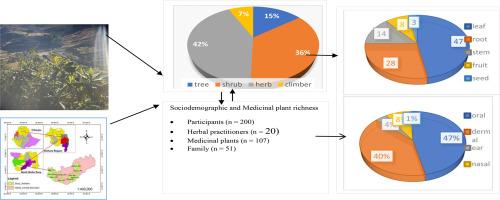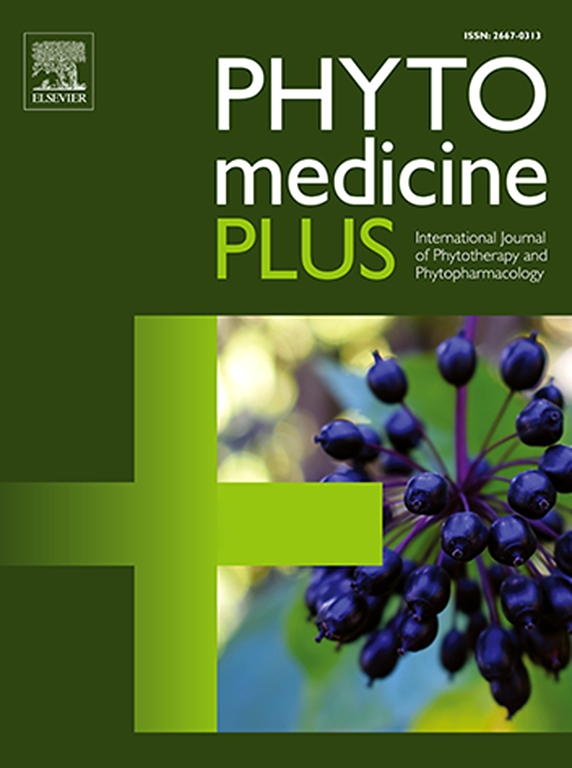埃塞俄比亚北部瓦德拉地区用于治疗人类疾病的药用植物:人种植物学方法
Q3 Pharmacology, Toxicology and Pharmaceutics
引用次数: 0
摘要
引言 在对抗疗法或现代医学出现之前,全球人口就开始使用传统医学来治疗多种疾病。据记载,近 887 种植物可治疗不同的健康问题。记录药用植物的传统用途是获取生物活性化学物质信息、保护本土知识以及最终发现有趣的药用植物物种的重要一步。本研究旨在记录用于治疗人类疾病的药用植物和相关本土知识。方法采用多种抽样技术收集数据,包括严格随机抽样、分层随机抽样(针对一般信息提供者)以及滚雪球抽样、目的性抽样和随机抽样(针对关键信息提供者)。我们采用了半结构式访谈、小组讨论、实地考察和实地观察等方法来收集数据。我们使用描述性统计对数据进行了分析,包括直接矩阵排名、偏好排名、信息提供者共识因素和忠实度水平。当地人共确定了隶属于 51 科 71 属的 107 种植物,用于治疗人类疾病。茄科植物的种类最多(7 种)。叶是用于配制药方的最主要植物部分(47%)。最常见的给药途径是口服(47%)。ICF 值最高的类别是神经系统疾病(0.96)。曼陀罗是治疗伤口的首选药材。Guizotia abyssinica 的忠实度最高(93.3%)。在多用途药用植物的直接矩阵排序中,球叶桉排名第一。虽然社区成员依靠药用植物物种来解决各种健康问题,但它们威胁着该国的药用植物,本土知识正在迅速从社区消失;因此,应采取保护措施,保护这些植物的自然生长地、农业区和村庄。本文章由计算机程序翻译,如有差异,请以英文原文为准。

Medicinal plants used to treat human ailments in Wadla District, Northern Ethiopia: An ethnobotanical approach
Introduction
The global population started using traditional medicine before the advent of allopathic or modern medicine to manage several diseases. Nearly 887 plant species have been documented to heal different health problems. Documenting the traditional use of medicinal plants is a vital step in obtaining information on bioactive chemicals, preserving indigenous knowledge and ultimately interesting, medicinal plant species. This study aimed to document medicinal plants and the associated indigenous knowledge used to treat human ailments.
Methods
The data were collected using a combination of sampling techniques, including strict random sampling, stratified random sampling, (for general informants) and snowball sampling, purposive and random sampling (for key informants). Semistructured interviews, group discussions, guided field walks, and field observations were used to collect the data. We analysed the data using descriptive statistics, including direct matrix rankings, preference rankings, informant consensus factors, and fidelity levels.
Results
A total of 200 informants (68 % males and 32 % females) living in 10 kebeles were selected. A total of 107 plant species belonging to 51 families and 71 genera were identified by local people to address human ailments. The Solanaceae family represented the greatest number of species (7 species). Leaves were the most dominant plant parts used for remedy preparation (47 %). The most common routes of administration were oral (47 %). The categories with the highest ICF values were diseases of the nervous system (0.96). Datura stramonium was the most preferred species for treating wounds. The highest fidelity level (93.3 %) was recorded for Guizotia abyssinica. Eucalyptus globulus was ranked first in a direct matrix ranking exercise of multipurpose medicinal plants.
Conclusion
This study revealed that the study area has a considerable number of traditional medicinal plants that are used to address a wide range of health problems. Although community members rely on medicinal plant species to manage various health problems, they threaten medicinal plants in the country, and indigenous knowledge is rapidly vanishing from communities; thus, conservation measures should be taken to protect these plants in their natural sites, agricultural areas and villages.
求助全文
通过发布文献求助,成功后即可免费获取论文全文。
去求助
来源期刊

Phytomedicine Plus
Medicine-Complementary and Alternative Medicine
CiteScore
3.70
自引率
0.00%
发文量
178
审稿时长
81 days
期刊介绍:
 求助内容:
求助内容: 应助结果提醒方式:
应助结果提醒方式:


